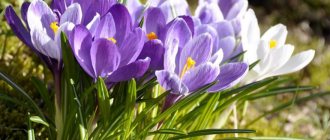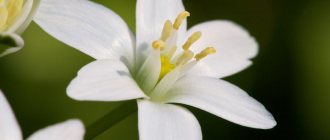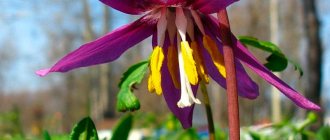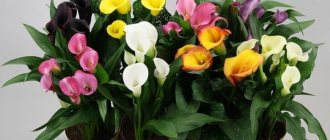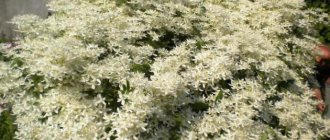At first glance, it may seem to inexperienced gardeners that garden tradescantia is an inconspicuous houseplant. This is far from true: a luxurious shrub will delight others with its beauty and unusualness for many years. The plant is easy to care for and hardy, so it is not at all difficult to achieve long-term flowering. You just need to follow a few simple rules and do not forget about the necessary care.
Description
Tradescantia garden is a herbaceous plant that belongs to the Commelinaceae family. It received its original name in honor of the gardener John Tradescant, who worked at the court of King Charles I of England, who reigned in the 17th century. The culture is distinguished by an enviable duration of flowering before the onset of frost.
The perennial garden tradescantia bush has a thickened fibrous root system and thin knotty shoots. The small-leaved bush grows from 20 cm to 1 meter in height, characterized by spreading leaves of bright green color that lie on the soil.
The buds are small in size, collected in umbrella inflorescences, have a delicate and attractive shape, as well as a variety of colors, namely purple, pink, blue, indigo, white. The fruit is a thin-walled capsule consisting of two halves on which the seeds are located.
Application
Due to its extraordinary attractiveness, Garden Tradescantia is actively used to decorate a personal plot and decorate a room. Among other things, the plant is used in the medical industry, as it has medicinal powers.
Medicinal properties
Tradescantia garden has a number of useful properties and is used in the fight against diseases such as:
- boils;
- infectious diarrhea;
- angina;
- runny nose;
- flatulence;
- diabetes;
- periodontal disease.
Substances contained in Tradescantia garden have antimicrobial, antiviral, wound-healing, and anti-inflammatory effects. In Asia and America, tradescantia is used to treat wounds.
Apartment decoration
Tradescantia domestica is a hanging species and is actively used to decorate houses and apartments. The location of the indoor plant should be selected in such a way that the flower has the opportunity to lower its stems. Hanging vases or flower pots are considered an ideal option. Pots can be placed on the surface of tall furniture or shelves.
Landscape design
Tradescantia garden allows you to arrange beautiful flower arrangements in landscape design. It has simple, delicate buds that brightly combine with many plants.
Excellent neighbors for tall varieties are hostas, brunners, anemones, swimsuits and astilbes, for low crops - mantles, geraniums, gravilates, lungworts.
Purchase and adaptation
Tradescantia virginiana has become widespread among amateur gardeners. You can buy freshly dug plants at the market or borrow from neighbors. Because of its simplicity, it is not often sold in flower shops; there is a much better chance of finding seedlings in nurseries. Prices are cheap: even modern hybrid varieties cost around 60-100 rubles.
Thanks to its frost resistance and unpretentiousness, adaptation is easy. But to facilitate rooting, it is recommended to shorten the shoots before planting - this way the plant will devote all its strength to the formation of new roots.
Varieties
In nature, there are a large number of different types of Tradescantia, each of which has its own botanical characteristics.
White-flowered
It got its name thanks to the characteristic white stripes on the oval leaves and light umbrella-shaped inflorescences at the top of the peduncle.
Zebrina
The ampelous plant has zebra-shaped leaves with a characteristic silvery sheen. Reaches 80 cm in height, rarely blooms, especially when grown at home.
Prirechnaya
A capricious type of garden Tradescantia, which has high decorative qualities. Ovate leaves with whitish hairs and a pleasant color combination. The color of the small buds varies from white to dark purple.
Bedspread
The variety was popular earlier, but now many gardeners look at it with a touch of nostalgia. This is an ornamental deciduous plant that grows quickly and is distinguished by its unique purple leaf color. In appearance it is associated with plants typical of Mexico and Florida.
Blossfeld
The garden variety of Tradescantia is easily recognized by its dense stems with a red tint. The leaves, with noticeable coarse hair, are dark green on the upper side and purple on the lower side.
See also
Growing, planting and caring for asters in open groundRead
Scaphoid
This type of garden tradescantia has no pubescence on the stem; the fleshy, boat-shaped leaves are small in size and have many purple dots on the surface.
Anderson
The bush is erect, up to 80 cm high. The leaves are green in color with a purple tint. Inflorescences vary in color from white to bright purple.
Sillamontana
Tradescantia Sillamontana is also known as “hairy” or “shaggy”. The species belongs to succulents and is characterized by fleshy leaves of bright green color. Medium sized purple buds.
Myrtifolia
Tradescantia with silver stripes on a background of dark green leaves, with a purple color on the bottom. The stem is thin, purple in color.
Hairy
This species is rarely seen. Its stems are straight, and its small leaves are covered with dense hairs that form a fluffy coating. The flowers have a bright pink-lilac color.
Virginskaya
The most common among gardeners is called “street”. An evergreen plant with a height of 30 to 80 cm, which is characterized by inflorescences of delicate pastel colors. The most famous variety in Russia, as it is cultivated in all its regions.
Wegelin
One of the most popular varieties due to its similarity to violet. It has bright blue flowers. During the growth process, the bush grows strongly and reaches a height of 50 cm. The variety is resistant to frost, so it can bloom from the first ten days of June until late autumn.
Charm mix
A perennial plant with a varied selection of shades: pink, white, blue, indigo, violet. It is sown already in early March, actively grows on fertile soils, the variety is quite unpretentious in care.
rosy bride
It differs from other varieties by the presence of pearlescent pink flowers and glossy bright leaves. The plant is not tall, no more than 40 cm. Flowering period: June - last ten days of August.
Reo
A beautiful unpretentious plant that pleases with annual flowering. The rosette of leaves increases by at least 10-15 cm per year. The inflorescences are covered with a bract, which forms a kind of cover.
Types of Tradescantia domestica with photos and names
White-flowered Tradescantia (Tradescantia albiflora)
The plant has ovate, striped leaves with alternating white and pale green colors. Shoots grow up to 50 cm long.
Tradescantia blossfeldiana
A species recognized by its dense, lance-shaped leaves and red-green stems. Leaf color is dark green. There is hair on the stems and at the base of the leaves.
River Tradescantia (Tradescantia fluminensis)
The leaves of wild-growing specimens have an even green color. But at home, you can get plants with striped or even spotted leaves.
Tradescantia navicularis
This is the most unusual look. Thick sheets are shaped like a boat. Their color can be green, purple, or red.
Striped Tradescantia (Tradescantia varius)
This look is very powerful. The plant has a strong stem up to 50 cm high. The leaves are also long. The length of the leaf can be more than 30 cm, width - 5-6 cm. The color of the leaf is purple below, green above, with faint stripes present.
Tradescantia sillamontana
The only species that can live in dry semi-desert conditions. This property is facilitated by the thick, long pile that covers the stems and leaves. This pile helps to accumulate moisture and protects against its loss.
However, the plant cannot live in cold conditions, so it must be kept in a warm room in winter.
Growing in open ground
For many, it is new that an ordinary indoor flower can be grown in open ground, since this luxurious perennial shrub is able to bloom for a long time and withstand unfavorable conditions. To admire its flowering all summer long, you need to know the features of growing Tradescantia garden in open ground.
Selecting a location
To grow Garden Tradescantia, you need to select a shaded place. The plant prefers areas with high humidity. Ideally, there should be a body of water near the place of growth. Sandstone is perfect for soil.
Soil preparation
The soil must be freed from weeds, loosened and organic fertilizers applied - vermicompost, peat or humus.
How to plant
Dig small holes in the prepared area and place the seedling vertically in them, straightening the root system. Cover with soil, leaving the root collar to rise 2-3 cm above the ground. Be sure to water the Tradescantia and mulch the area near the root with peat or humus. If the seedling was kept at home, it is recommended to cover it with special material for several days. When it takes root, the cover must be removed. If the varieties are tall, you should take care of a reliable support or garter.
Caring for Tradescantia after purchasing from a store
For any plant purchased in a store, you must adhere to the quarantine rule. So it is with Tradescantia. If you bought it at a retail outlet, give the flower a week or two to adapt to new conditions.
During this short time, diseases or pests that could be dormant in the store will definitely make themselves known.
The purchased plant will also need to be replanted. But if the plant was purchased in autumn or winter, then it is better to wait until spring and only then transplant it into a new pot.
RULE : you need to change not only the pot, but also the soil. To better separate the soil from the roots, hold the flower with a lump of earth in water. After just a couple of minutes, the soil will easily separate.
In other seasons, the plant can be safely replanted after 1-2 weeks of quarantine.
Care
Despite its unpretentiousness, the plant needs proper care, timely feeding, regular watering, pruning and periodic replanting.
Watering
Watering should be given special attention, since Garden Tradescantia is not indifferent to moisture, especially if it is located in the sun. You need to water abundantly and regularly.
With insufficient moisture and heat, the plant stops growing, stops flowering and may even die.
Top dressing
Frequent application of fertilizers can harm the growth and development of Tradescantia garden. In order not to cause harm to the crop, you need to follow the feeding schedule.
First
At the first stage, when the first shoots appear, add a complex of mineral fertilizers.
Second
The next feeding is carried out at the moment of bud formation.
Rest
This is enough for the active growth and development of the plant. If planting was carried out in soil that is rich in clay, then in the coming years you should completely abstain from fertilizers. The rest of the feeding is carried out exclusively as needed.
Fertilizer
It is recommended to use a complex product based on mineral fertilizers as a fertilizer. You can alternate fertilizing with organic matter.
Diseases and harmful insects
If a flower is sick, it is caused by a violation of climatic conditions. Dry air is the most likely cause of leaf edges drying out. If the plant's foliage turns brown, it is overwatered. If the lower shoots become exposed, this means that pruning has not been done for a long time.
An insufficient amount of light affects the height of the stems (they become stretched) and the color of the leaves (variegation is replaced by greenery). Lack of moisture can explain slower growth and yellowing of leaves.
If the diseases described above are not eliminated in a timely manner, the flower may dry out.
As for harmful insects, saxifrage is afraid of aphids, scale insects and spider mites. If you maintain a certain microclimate in the room, pests will not appear.
Tradescantia is a popular indoor plant. The love of gardeners for it is explained by its decorativeness and unpretentiousness in maintenance. Even a beginner in floriculture can cope with growing this flower.
Seasonal maintenance at home
During the cold season, garden tradescantia can be replanted in pots and brought into the house, but in order to avoid habituation and severe stress due to temperature changes, it is better to leave it in the open ground, cutting it off and covering it with special material for the winter.
See also
When to dig up gladioli bulbs, terms and storage rules, preparation for winterRead
Garden tradescantia in landscape design
- This decorative, long-blooming perennial has long been used by landscape designers to design flower beds, create flower arrangements, decorate the coastal zone of a reservoir, etc.
- Tradescantia garden looks great with other flowers, shrubs and herbaceous plants. When composing decorative compositions, it is important to take into account the height of the plants so that they do not cover, but complement each other. The most successful combinations of aesthetic Tradescantia with ferns, heucheras, daylilies, hostas and astilbes.
- Taking into account the preferences of a perennial crop, it is planted in shaded mixborders, in the lowlands of alpine hills, near fences or in the shade of any buildings. A well-chosen location will provide owners of this garden beauty with bright greenery and an abundance of delicate flowers throughout the warm season.
- When choosing a variety of Tradescantia, you should remember about the possible lodging of tall Tradescantia (especially in open and unprotected areas), which will significantly worsen the decorative attractiveness of the flower garden. In this case, well-chosen “plant neighbors” can become a real natural support for the spreading tradescantia bushes.
To summarize, we note that garden tradescantia is a hardy and unpretentious plant grown in open ground. Among the main requirements for successful cultivation of a perennial and long-blooming beauty are constantly moist soil and diffused lighting. Dividing and replanting (every 5 years) an overgrown Tradescantia shrub ensures rejuvenation of the plant, greatly increasing the intensity of flowering. Bright and decorative culture is irreplaceable in the design of many landscape designs, in particular when composing a variety of flower arrangements.
Planting and replanting into new soil
At least once every 4 years it is necessary to replant garden Tradescantia bushes into a different soil.
Soil preparation
High-quality soil should contain mineral and organic substances.
Why do you need a shallow pot?
The root system of Garden Tradescantia grows proportionally, so to replant the plant you need a standard size pot. This should be a trapezoidal container, the top of which is at least 3 cm larger than the bottom.
How to transplant
The plant needs to be dug up a little and carefully pulled out of the soil, being careful not to damage the root system. Then place it in the selected container, sprinkle it with soil mixture and water it.
Landing technology
Planting perennial tradescantia in open ground flower beds must be carried out in accordance with the following recommendations:
- Tradescantia in open ground needs a very sunny or lightly shaded area, without through and gusty winds;
- It is optimal to grow ornamental crops near bodies of water;
- the soil on the site for growing Tradescantia should be fertile, fairly light, with slightly acidic properties;
- the soil in flower beds should not only be light in composition, but also have optimal air permeability and water permeability;
- The best soil composition for growing Tradescantia is based on turf and leaf soil, sand and humus.
It is important to note that in addition to aesthetic qualities, almost all types of Tradescantia are distinguished by the presence of the following medicinal properties:
- antibacterial effect;
- beneficial effect on the respiratory system;
- prevention of colds;
- treatment and prevention of periodontal disease;
- prevention of certain gastrointestinal diseases;
- prevention and treatment of furunculosis.
Thus, growing garden tradescantia is a very useful activity and not particularly difficult. Outdoor ornamental crops practically do not cause problems for gardeners, are frost-resistant, and are extremely rarely damaged by pests and pathogenic microflora.
Care
It is with Tradescantia that it is recommended to begin your work in the garden. The plant needs additional care, although it is an undemanding crop.
Watering
Regular watering is the first requirement of the plant. Tradescantia garden does not tolerate drought.
Top dressing
Feeding is optional, but during the growing season and budding it is better to feed the flower using complex fertilizers based on minerals and organic matter.
Bloom
At the end of the flowering period, it is recommended to remove the flower stalks in a timely manner so that seedlings do not fall into the soil, which can sprout the next year and randomly thicken the bush.
Wintering
For the winter, it is necessary to cut off the above-ground part of the plant and mulch the soil with peat or humus. Otherwise, Tradescantia may not survive the winter period.
Trimming
As it grows, it will produce long, bare stems that require pruning. It should be carried out in the spring. The resulting cut can be used as a cutting.
Growing and Reproduction
Tradescantia garden is propagated vegetatively. To do this, you need to separate the cutting from the bush and put it in water. You can plant the cuttings in moist soil, and the very next day roots will appear. Thus, the plant quickly takes root and will soon delight you with lush bushes.
A possible propagation option is by dividing the bush. To do this, you need to divide the bush into equal parts and plant it in prepared, moist soil. The roots of the plant are quite strong, so you can use scissors when dividing it.
Tradescantia is often grown from seeds, but when propagated in this way, it often loses its varietal characteristics. In order to grow a plant by seed, you will need well-moistened, fertile soil. Sowing is done before winter; in the spring you will need to pick the seedlings.
Care errors
Possible mistakes that novice gardeners make include:
- overfeeding the plant with nitrogen-based fertilizers;
- nearby heating devices;
- exposure to direct sunlight or, conversely, localization of the plant in the shade;
- water stagnation.
Errors are accompanied by withering or rotting of Tradescantia, its immediate death.
Diseases and pests
Tradescantia garden is resistant to diseases and can resist them even in the absence of proper care. But despite this, ornamental plants can be affected by various pests, which must be controlled with the help of special insecticides.
Spider mite
A small insect that is very difficult to notice due to its small size and frequent location on the back of the leaf. It looks like a dark grain no more than 0.5 mm.
Aphid
An insect that is easy to spot due to the fact that they usually gather in groups and form a noticeable white coating. This pest is very insidious, as it can carry dangerous viruses.
Shchitovka
The tiny insect looks like a flat aphid with a shell. Its invasion is signaled by small brown plaques appearing on the leaves and stems, which lead to the foliage turning pale and falling off.
Slugs
Gastropods crawl and eat the leaves of Tradescantia garden. They are difficult to spot because they are nocturnal.
The benefits of Tradescantia
Tradescantia is grown not only for its decorative value. Flower growers love it for its medicinal qualities - saxifrage purifies air and water well, and also neutralizes electromagnetic radiation.
In addition, this plant protects against diseases of the respiratory tract, gastrointestinal tract, and sore throat. Also, if you tie a leaf to the wound, you can stop the bleeding. However, it should be remembered that certain types of saxifrage are poisonous, for example, pale tradescantia.
